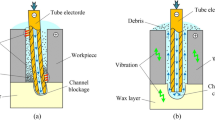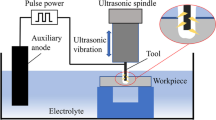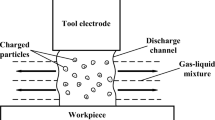Abstract
Spark-assisted electrochemical machining (SAEM) is an advanced machining method, which can manufacture microstructures on non-conductive hard and brittle materials such as glass. However, there are still some technological problems in the process of SAEM, among which the poor machining localization and the damage of microhole outlet are still unresolved. In order to improve the localization and quality of machining, a method of ultrasonic vibration–assisted spark-assisted electrochemical drilling (UASAED) was proposed in this paper. The application of ultrasonic vibration can reduce the gas film thickness and improve its stability in the spark-assisted electrochemical machining process, and reduce the discharge energy, so the machining localization and quality can be improved. Firstly, the formation of gas film in the drilling process was simulated and the influence of ultrasonic vibration on the gas film was analyzed. Secondly, the mechanism of material removal during drilling process was studied and simulated, and the mathematical model was established. Then, through a series of experiments, according to the established mathematical model, the relationships between the key machining parameters and the machining localization were studied, and the experimental results were consistent with the simulation. Finally, according to the machining parameters optimized by single factor experiments, 4 × 5 high-quality glass microhole array was successfully machined. The diameters of microholes were significantly reduced, with the inlet diameter decreasing by 20.59% and the outlet diameter by 14.9%, which indicated that ultrasonic vibration–assisted spark-assisted electrochemical drilling is an effective method to improve the machining localization.


























Similar content being viewed by others
Availability of data and material
All data generated or analyzed during this study are included within the article.
Code availability
Not applicable.
References
Chang W, Hsihe Y (2016) Multilayer microheater based on glass substrate using MEMS technology. Microelectron Eng 149:25–30
Hof LA, Ziki JA (2017) Micro-hole drilling on glass substrates-a review. Micromachines 8(2):53
Lee J, Lee S, Lee S, Park J (2013) Through-glass copper via using the glass reflow and seedless electroplating processes for wafer-level RF MEMS packaging. J Micromech Microeng 23(8):85012
Kannojia HK, Arab J, Pegu BJ, Dixit P (2019) Fabrication and characterization of through-glass vias by the ECDM process. J Electrochem Soc 166(13):D531-538
Khan AA, Haque MM (2007) Performance of different abrasive materials during abrasive water jet machining of glass. J Mater Process Technol 191(1):404–407
Ahmed N, Darwish S, Alahmari AM (2016) Laser ablation and laser-hybrid ablation processes: a review. Mater Manuf Processes 31(9):1121–1142
Lv D, Wang H, Tang Y, Huang Y, Li Z (2013) Influences of vibration on surface formation in rotary ultrasonic machining of glass BK7. Precis Eng 37(4):839–848
Iliescu C, Chen B, Miao J (2008) On the wet etching of Pyrex glass. Sens Actuators, A 143(1):154–161
Singh T, Dvivedi A (2016) Developments in electrochemical discharge machining: a review on electrochemical discharge machining, process variants and their hybrid methods. Int J Mach Tools Manuf 105:1–13
Torabi A, Razfar MR (2021) The capability of ECDM in creating effective microchannel on the PDMS. Precis Eng 68:10–19
Kurafugi H, Suda H (1968) Electrical discharge drilling of glass. CIRP Ann Manuf Technol 16(1)
Zou R, Yu Z, Yan C, Li J, Liu X, Xu W (2018) Micro electrical discharge machining in nitrogen plasma jet. Precis Eng 51:198–207
Spieser A, Ivanov A (2013) Recent developments and research challenges in electrochemical micromachining (µECM). Int J Adv Manuf Technol 69(1–4):563–581
Huang L, Cao Y, Jia F, Lei Y (2020) Study on the stability of gas film in electrochemical discharge machining of ultra-white glass micro array holes. Microsyst Technol 26(3):947–955
Rathore RS, Dvivedi A (2020) Sonication of tool electrode for utilizing high discharge energy during ECDM. Mater Manuf Processes 35(4):415–429
Wüthrich R, Hof LA (2006) The gas film in spark assisted chemical engraving (SACE)—a key element for micro-machining applications. Int J Mach Tools Manuf 46(7):828–835
Pawariya K, Dvivedi A, Singh T (2019) On performance enhancement of electrochemical discharge trepanning (ECDT) process by sonication of tool electrode. Precis Eng 56:8–19
Tricarico C, Delpretti R, Dauw DF (1988) Geometrical simulation of the EDM die-sinking process. CIRP Ann 37(1):191–196
Marafona J, Chousal JAG (2006) A finite element model of EDM based on the Joule effect. Int J Mach Tools Manuf 46(6):595–602
Jui SK, Kamaraj AB, Sundaram MM (2013) High aspect ratio micromachining of glass by electrochemical discharge machining (ECDM). J Manuf Process 15(4):460–466
Cheng C, Wu K, Mai C, Hsu Y, Yan B (2010) Magnetic field-assisted electrochemical discharge machining. J Micromech Microeng 20(7):075019
Han M, Min B, Lee SJ (2007) Improvement of surface integrity of electro-chemical discharge machining process using powder-mixed electrolyte. J Mater Process Technol 191(1):224–227
Singh T, Dvivedi A (2018) On pressurized feeding approach for effective control on working gap in ECDM. Mater Manuf Processes 33(4):462–473
Arab J, Mishra DK, Kannojia HK, Adhale P, Dixit P (2019) Fabrication of multiple through-holes in non-conductive materials by electrochemical discharge machining for RF MEMS Packaging. J Mater Process Technol 271:542–553
Kolhekar KR, Sundaram M (2018) Study of gas film characterization and its effect in electrochemical discharge machining. Precis Eng 53:203–211
Han M, Min B, Lee SJ (2009) Geometric improvement of electrochemical discharge micro-drilling using an ultrasonic-vibrated electrolyte. J Micromech Microeng 19(6):065004
Rusli M, Furutani K (2012) Performance of micro-hole drilling by ultrasonic-assisted electro-chemical discharge machining. Adv Mater Res 445:865–870
Elhami S, Razfar MR (2018) Effect of ultrasonic vibration on the single discharge of electrochemical discharge machining. Mater Manuf Processes 33(4):444–451
Chang W, Chen Y, Zhang J, Gu X, Fang M (2015) Ultrasonic vibration aided electrical-discharge milling flow field and debris distribution field simulation. J Basic Sci Eng 23:151–157
Klausner JF, Mei R, Bernhard DM, Zeng LZ (1993) Vapor bubble departure in forced convection boiling. Int J Heat Mass Transfer 36(3):651–662
Funding
Financial support was received from the National Key R&D Program of China (No. 2018YFB2001400), the National Natural Science Foundation of China (No. 52005298), the Natural Science Foundation of Shandong Province (No. ZR2021ME048), and the Key R&D Program of Shandong Province (No. 2019GGX104023), and this work is also supported by Physical–Chemical Materials Analytical & Testing center of Shandong University at Weihai.
Author information
Authors and Affiliations
Contributions
Yong Liu contributed to the conception of the study; Tianbo Wang performed the experiment, contributed significantly to analysis and manuscript preparation, performed the data analyses, and wrote the manuscript; others helped perform the analysis with constructive discussions.
Corresponding author
Ethics declarations
Ethics approval
Compliance with ethical standards.
Consent to participate
All authors agreed with the consent to participate.
Consent for publication
All authors have read and agreed to the publication of the paper.
Competing interests
The authors declare no competing interests.
Additional information
Publisher's Note
Springer Nature remains neutral with regard to jurisdictional claims in published maps and institutional affiliations.
Rights and permissions
About this article
Cite this article
Wang, T., Liu, Y., Lv, Z. et al. Theoretical and experimental study on localization improvement in ultrasonic vibration–assisted spark-assisted electrochemical drilling process. Int J Adv Manuf Technol 121, 5311–5328 (2022). https://doi.org/10.1007/s00170-022-09642-x
Received:
Accepted:
Published:
Issue Date:
DOI: https://doi.org/10.1007/s00170-022-09642-x




